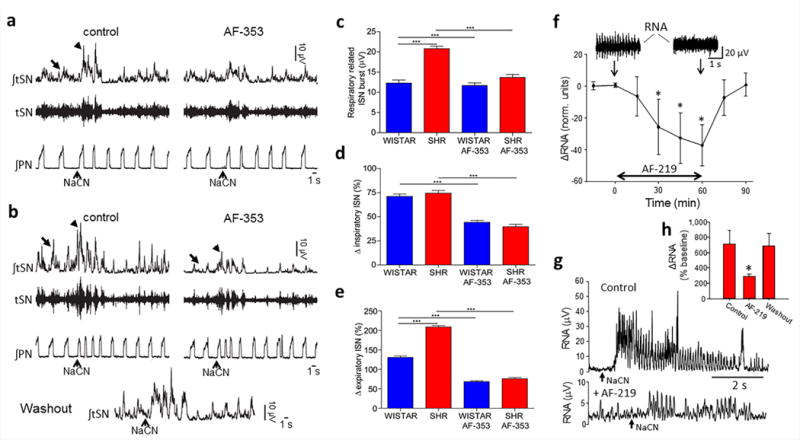Figure 5.

The anti-hypertensive action of P2X3 receptor antagonism is associated with a reduction in sympathetic activity in spontaneously hypertensive (SH) rats in situ and in vivo. A comparison of the effect of a P2X3 receptor antagonist (AF-353; 20 μM, 15 nl) applied locally to both carotid bodies on the ongoing thoracic chain sympathetic activity (arrow, raw: tSN; integrated: ∫tSN) and the sympathetic nerve reflex response (arrow head) to peripheral chemoreceptor stimulation (evoked by NaCN, 22.5 μg i.a.) in 12 Wistar (a) and 12 SH rats (b). The effect of P2X3 receptor antagonism within both carotid bodies on the basal (c), inspiratory- (d) and expiratory (e) modulated tSN for both rat strains is shown (n = 12 each). Inspiratory and expiratory modulation of tSN was determined using averaged triggering from the phrenic nerve (PN). One-way ANOVA Bonferroni post-test; data are mean ± s.e.m. from in situ rat preparations (n = 12 each strain). (f), renal sympathetic nerve activity (RNA) recorded from conscious radio697 telemetered in vivo SH rats (n = 5) during infusions of AF-219 (8 mg/kg/h i.v.). Note the similar time course of the response in RNA to the fall in systolic blood pressure depicted in Fig. 4(a). A representative example of the peripheral chemoreflex evoked sympathoexcitatory response (NaCN 22.5 μg i.a.) in a conscious radio-telemetered SH rat before and after AF-219 (g) with mean data shown in (h), which includes drug washout data. Repeated measures one-way ANOVA, with Holm-Sidek post-hoc comparison. n = 5, * P < 0.05, *** P < 0.001.
